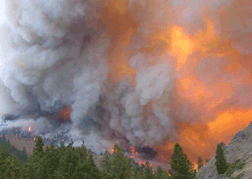
NPS Change is a constant process in the Great Basin. Flash floods scour stream channels, avalanches roar through spruce forests, and rock glaciers melt from mountain peaks. Change is an ever present natural process, however change in the Great Basin is accelerating at an unprecedented scale. Pinyon and juniper woodlands are expanding into areas once dominated by sagebrush grasslands. Non-native species like cheatgrass are spreading rapidly (4,000 acres per day) and currently cover one third of the Great Basin (25 million acres). Wildfire size and frequency is increasing, while species like sage grouse are decreasing. These are all recent changes, occuring over the last 100 years, and human's suppression of fire is partially responsible. 
NPS The Role of FireFire has always been an important force in the Great Basin, changing and shaping plant communities for the past 10,000 years. Without fire, these communities become choked with vegetation, and soon pinyon and juniper trees begin to invade. As the time between fires increases, pinyon and juniper tree canopies extend and expand, out competing grasses and shrubs for sunlight. The plant community shifts from a shrub dominated grassland to a tree dominated woodland. Evidence of this change is shown by the abundance of sagebrush and other shrub "skeletons" still present in the pinyon-juniper woodlands. The ecological implications of this change are profound. Woodlands are less productive and support fewer plants and animals than sagebrush steppe habitats. Although an absence of fire is responsible for shifting sagebrush steppe grasslands to woodlands, once the shift has occurred fire becomes a threat instead of an ally to the system. Excessive fuel loads and ladder fuels in woodlands allow fire to easily move into tree canopies where it burns with extreme intensity, killing all plants and compromising the soil's ability to support life. Extreme fires set the stage for invasion by non-native plants, like cheatgrass. 
NPS Making It RightGreat Basin National Park recognizes the role of fire in maintaining ecosystems. It also recognizes the inherent ecological risks now present because of past fire suppression and non-native plants like cheatgrass. In an effort to restore fire as a tool of change in maintaining healthy ecosystems, the park has undertaken several fuels reduction and sagebrush steppe restoration projects. The goal of these projects is to reduce excessive fuel loads and to restore healthy, resilient plant communities. If these goals can be met, fire may be reintroduced back into the system, reducing the potential for a catastrophic fire and the potential for cheatgrass invasion. 
NPS Photo Fire ManagementWildland Fire:Wildland fire has great potential to change park landscapes more often than volcanoes, earthquakes or even floods. Such forces of change are completely natural. Many plants and animals cannot survive without the cycles of fire or flooding to which they are adapted. If all fire is suppressed, fuel builds up and makes bigger fires inevitable. Under certain conditions, large, hot fires can threaten public safety, devastate property, damage natural and cultural resources, and be expensive and dangerous to fight. Prescribed Fire:Prescribed fire is one of the most important tools used to manage fire today. In most parks, prescribed fires are used to manage vegetation instead of lightning-caused fires. A scientific prescription for the fire, prepared in advance, describes its objectives, fuels, size and the ideal environmental conditions for it to burn. If it moves outside the predetermined area, the fire may be suppressed. The fire may be designed to create a mosaic of diverse habitats for plants and animals, to help an endangered species recover, or to reduce fuels and thereby prevent a destructive fire. Burning key areas in advance, thereby removing fuels from the path of a future unwanted fire, can protect specific buildings, cultural resources, critical natural resources, and habitats. Fuel buildups sometimes must be cut and removed by hand. By burning away accumulated fuels and protecting specific sites, planned fires make landscapes safer for future natural fires. Structural Fire:Part of the NPS mission is to protect the resources entrusted to its management, including buildings and structures, irreplaceable cultural resources, valuable property and infrastructure. Great Basin's Fire Management PlanEvery national park with a fire program follows a Fire Management Plan (FMP). This plan is tied to the park's Resource Management Plan, and is a detailed program of action that provides specific procedures to accomplish park management policies and objectives. The implementation of this plan allows fire to play its ecological role in Great Basin, while protecting human life, developments and cultural resources. The National Park Service Fire and Aviation Management website provides more insight into fire operations in national parks.To learn more about fire management in the National Park Service, visit www.nps.gov/fire |
Last updated: September 27, 2024
